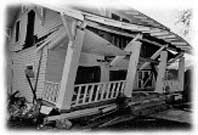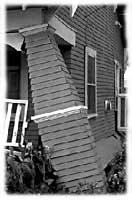

August
15, 1994
The severe shock -- now reassessed at magnitude 6.7 -- also forced scientists to revise their estimates of the seismic hazard facing the densely inhabited suburbs of metropolitan Los Angeles. In the most comprehensive assessment of the Northridge earthquake so far, the scientists of the U.S. Geological Survey and the Southern California Earthquake Center say that people in the Los Angeles area should expect at least one earthquake every year of magnitude 5.0 or more for the foreseeable future. There is a 45% likelihood of another Northridge aftershock above magnitude 5.0 by the end of July. The scientists said that with almost 100 faults in the Los Angeles area known to be capable of a magnitude 6.0 or greater earthquake, emergency planners must recognize that urban earthquakes can no longer be considered rare events. Over the long run, contractors should expect that homes and buildings might be subjected to severe ground shaking -- at the extremes of the stresses considered in present building codes -- several times in the structure's lifetime. The full extent of the urban corridor from San Bernardino through Los Angeles and northwest to Santa Barbara is at risk.
October
23, 1994 There is a 45 percent likelihood of another aftershock above a magnitude of 5.0 from the Northridge Quake by the end of July, the study found. The 6.7 magnitude earthquake left 61 dead and caused at least $20 billion in damage. A team of scientists from the California Institute of Technology, University of Southern California, NASA's Jet Propulsion Laboratory, Columbia University and University of California, San Diego, used data from sensors that have been installed across the region. They paid particular attention to buildings and codes. "There was a debate over what happens when you are right on top of an earthquake," said Lucille M. Jones, a U.S. Geological Survey seismologist who headed the team."That argument is over." The study, reported Friday in the journal Science, found "that the northern Los Angeles region faces one of the greatest seismic hazards in Southern California." There are so many faults that any safety efforts have to be regional in scope, said Thomas L. Henry, executive director of the Southern California Earthquake Center at USC. Nearly 100 faults in the Los Angeles area are capable of a magnitude 6.0 or greater earthquake, so they shouldn't be considered rare events, the scientists said. "This is an incredibly complex web of faults underlying all of Los Angeles - more complex than we thought," Jones said. The Northridge Quake left more than 3,000 buildings unsafe, but the scientists blamed much of the damage on faulty construction and inadequate building inspections. Simple measures such as securing computers, lights, pipes and bookcases could save millions, the study suggested. "The emphasis on protecting against loss of life says nothing about the cost of repair to restore the buildings to usability," said Douglas Dreger, a UC Berkeley seismologist who agreed with the findings. "Under the present codes, the buildings may not collapse but may not ever be usable again. It may be advisable to strengthen the codes to prevent much more of the damage that can occur in strong earthquakes." |

 The
Northridge trembler in January, the most costly American earthquake
since 1906, measurably rearranged more than 1,900 square miles of
metropolitan Los Angeles, leaving portions two feet higher than
before, according to a wider-ranging report released today.
The
Northridge trembler in January, the most costly American earthquake
since 1906, measurably rearranged more than 1,900 square miles of
metropolitan Los Angeles, leaving portions two feet higher than
before, according to a wider-ranging report released today.  Residents
should expect at least one earthquake of magnitude 5.0 or greater
every year, and they should strengthen buildings to withstand the
repeated shocks, according to the most comprehensive report so far
on the Jan. 17 quake.
Residents
should expect at least one earthquake of magnitude 5.0 or greater
every year, and they should strengthen buildings to withstand the
repeated shocks, according to the most comprehensive report so far
on the Jan. 17 quake.